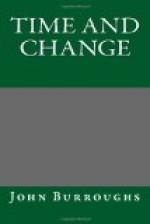The spring birds always awaken a thrill wherever I am. The first bobolink I hear flying over northward and bursting out in song now and then, full of anticipation of those broad meadows where he will soon be with his mate; or the first swallow twittering joyously overhead, borne on a warm southern breeze; or the first high-hole sounding out his long, iterated call from the orchard or field—how all these things send a wave of emotion over me!
Pleasures of another kind are to find a new bird, and to see an old bird in a new place, as I did recently in the old sugar-bush where I used to help gather and boil sap as a boy. It was the logcock, or pileated woodpecker, a rare bird anywhere, and one I had never seen before on the old farm. I heard his loud cackle in a maple tree, saw him flit from branch to branch for a few moments, and then launch out and fly toward a distant wood. But he left an impression with me that I should be sorry to have missed.
Nature stimulates our aesthetic and our intellectual life and to a certain extent our religious emotions, but I fear we cannot find much support for our ethical system in the ways of wild Nature. I know our artist naturalist, Ernest Thompson Seton, claims to find what we may call the biological value of the Ten Commandments in the lives of the wild animals; but I cannot make his reasoning hold water, at least not much of it. Of course the Ten Commandments are not arbitrary laws. They are largely founded upon the needs of the social organism; but whether they have the same foundation in the needs of animal life apart from man, apart from the world of moral obligation, is another question. The animals are neither moral nor immoral: they are unmoral; their needs are all physical. It is true that the command against murder is pretty well kept by the higher animals. They rarely kill their own kind: hawks do not prey upon hawks, nor foxes prey upon foxes, nor weasels upon weasels; but lower down this does not hold. Trout eat trout, and pickerel eat pickerel, and among the insects young spiders eat one another, and the female spider eats her mate, if she can get him. There is but little, if any, neighborly love among even the higher animals. They treat one another as rivals, or associate for mutual protection. One cow will lick and comb another in the most affectionate manner, and the next moment savagely gore her. Hate and cruelty for the most part rule in the animal world. A few of the higher animals are monogamous, but by far the greater number of species are polygamous or promiscuous. There is no mating or pairing in the great bovine tribe, and none among the rodents that I know of, or among the bear family, or the cat family, or among the seals. When we come to the birds, we find mating, and occasional pairing for life, as with the ostrich and perhaps the eagle.




